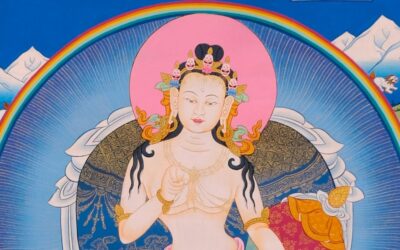Translation as Adaptation

Written By Grégoire Langouet
Blog | Reflections on translation
In this article Gregoire explains us what it is to translate Dzogchen, a few of its pitfalls and a sip of its endless possibilities.
Rigpa – the essence of the tradition
The translation of Tibetan texts into English is a direct application of what the Dzogchen Today! project is all about.
It is a typical example of the necessary adaptation of the tradition to the current conditions. We need texts that speak to us directly, with today’s perspective. For that matter, we have to play with the cultural biases, sometimes difficult to pierce, and with periods, sometimes very distant from us. Simple and direct translations, as natural as possible, carrying the heart and essence of the tradition, that’s what the Dzogchen Today! translation committee has to achieve!
The adaptation, not to say the alteration, that any translation must undergo, is inevitable when passing from one language to another, from one cultural area to another, from one container (the language) to another. The form, the ”container” changes, but not the heart of the message, the essence of the transmission, which is the nature of the mind itself, the “content” (which, in fact, is not contained because it is not something by itself, but that is another subject you will find dealt with in the tag category nature of the mind). Dzogchen tradition uses to call it rig pa.
How to ?
It is therefore a question of translating as one would walk a thin ridge, with delicacy and assurance, between two pitfalls to be avoided: on the one hand, the ravine of sterile conservation of the past, a kind of dusty museification; and on the other, the abyss of creative fashionable innovations, far from any direct experience, the essence of the tradition.
Translation is also like shooting an arrow from the past into the future. Or like pouring water from one container to another : between fidelity to a legacy to be preserved, and an adaptation to the conditions of the modern world. But the arrow has to be picked up and shot anew, such as the water has to be stirred up, for both to stay alive and continue their journey. With both metaphors, the arrow and the water, to remain ”charged” and full of the original energy, they thus need to be activated like the Dzogchen lineage is by the thunder of the transmission and the rain of blessings.
Try again. Fail again. Fail better.
And succeed?
Since there is no homogeneity in current translations from Tibetan to English, it is possible to continue experimenting, to discover what works best. Some widely used translations may need to be revised. New terms will be suggested. Readers and practitioners will be the only judges!
The transmission of a tradition from one cultural area to another, here from Asia to Europe, always takes time, a lot of time! It is not on the scale of a human lifetime that we should think. 500 years seems reasonable. We might as well start now!
Direct experiences
The main point in these translations will be to keep the heart, to convey the meaning, and thus to make possible the corresponding experiences. For a text without experience remains a dead letter. Traditionally most texts were reminders of what is to be realized. The written notes of an oral transmission.
The transmission of the meaning -the teaching of the tradition- is made to offer the right conditions for its realization through the personal experiences of the practitioners; a realization that is always intimate and singular. A simple hearing, reading or recitation of such texts can give a taste of the ultimate experience it conveys.
So we do not have to cling to the literal meaning out of misplaced loyalty. A Dzogchen text is not a museum, nor an idyllic nature reserve to be protected. Nor is it an old legend from the past, as if the translator, finally modern and enlightened, knew more than the writer, archaic and outdated!
Such texts are the transmission of a direct experience, of a living practice -they vibrate like spontaneous songs, like the music of the spheres. If we make our way into it today, resonating with it, integrating it into our lives, then it will be transmittable for tomorrow.
The translators
The more profound and repeated are the practice experiences of the translators -the passers and transmitters of words-, the more their realization will be stable (little by little, slowly but surely), and the more it will then be possible for them to play freely with the forms, with the “container”.
Creating, experimenting, having fun!
Because confidence and certainty will be present for them. It is when one is not sure and doubts that one clings to the literalness of meaning, fearing to lose it. Daring to change the forms, to adjust the ornaments, the radiant appearances, is what will help to keep the lineage of that tradition alive. This is our bet. And the more varied the forms, the more different people can be reached.
To keep it as simple, natural and direct as possible. To adapt the vocabulary and the examples so that it touches us here and now. To make accessible and practicable a form of life, a spiritual path for today, in our world. A path that holds unimaginable treasures of depth and simplicity. All this is the very essence of Dzogchen Today! The translation of the Dzogchen texts is an essential aspect of it. The first excerpts should be available next year. Ready for a taste of this new old adventure?
More Posts
The ground of all Künshi
This article “The ground of all, Künshi” provide a better understanding of the essential words and concepts of Dzogchen.
The Four Testaments of the Vidyādharas
This article from Grégoire presents the" Four Testaments of the Vidyādharas", essential teachings from the early masters of Dzogchen.
The Story of the First Masters: Garab Dorje
“The Story of the First Masters: Garab Dorje” is the first article in a new category about the masters of the Dzogchen lineage.
A Garland of Light
In “A Garland of Light”, Johanne talks about the way the lineage of the Great Perfection is passed on, since its beginning.
Stories When the Light Fades
In “Stories When the Light Fades”, Mila Khyentse recalls some of his Master’s Jack-o’-lantern stories told at night.
The ground (gzhi)
This article is the first in a new category designed to provide a better understanding of the essential words and concepts of Dzogchen.









